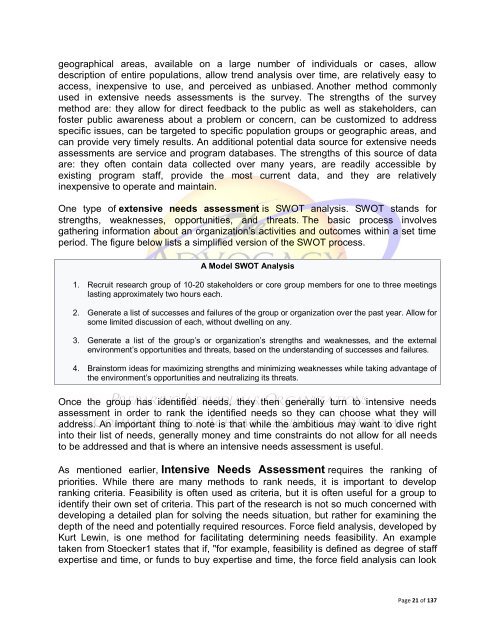Community Needs Assessment Process
Community Needs Assessment Process
Community Needs Assessment Process
You also want an ePaper? Increase the reach of your titles
YUMPU automatically turns print PDFs into web optimized ePapers that Google loves.
geographical areas, available on a large number of individuals or cases, allow<br />
description of entire populations, allow trend analysis over time, are relatively easy to<br />
access, inexpensive to use, and perceived as unbiased. Another method commonly<br />
used in extensive needs assessments is the survey. The strengths of the survey<br />
method are: they allow for direct feedback to the public as well as stakeholders, can<br />
foster public awareness about a problem or concern, can be customized to address<br />
specific issues, can be targeted to specific population groups or geographic areas, and<br />
can provide very timely results. An additional potential data source for extensive needs<br />
assessments are service and program databases. The strengths of this source of data<br />
are: they often contain data collected over many years, are readily accessible by<br />
existing program staff, provide the most current data, and they are relatively<br />
inexpensive to operate and maintain.<br />
One type of extensive needs assessment is SWOT analysis. SWOT stands for<br />
strengths, weaknesses, opportunities, and threats. The basic process involves<br />
gathering information about an organization’s activities and outcomes within a set time<br />
period. The figure below lists a simplified version of the SWOT process.<br />
A Model SWOT Analysis<br />
1. Recruit research group of 10-20 stakeholders or core group members for one to three meetings<br />
lasting approximately two hours each.<br />
2. Generate a list of successes and failures of the group or organization over the past year. Allow for<br />
some limited discussion of each, without dwelling on any.<br />
3. Generate a list of the group’s or organization’s strengths and weaknesses, and the external<br />
environment’s opportunities and threats, based on the understanding of successes and failures.<br />
4. Brainstorm ideas for maximizing strengths and minimizing weaknesses while taking advantage of<br />
the environment’s opportunities and neutralizing its threats.<br />
Once the group has identified needs, they then generally turn to intensive needs<br />
assessment in order to rank the identified needs so they can choose what they will<br />
address. An important thing to note is that while the ambitious may want to dive right<br />
into their list of needs, generally money and time constraints do not allow for all needs<br />
to be addressed and that is where an intensive needs assessment is useful.<br />
As mentioned earlier, Intensive <strong>Needs</strong> <strong>Assessment</strong> requires the ranking of<br />
priorities. While there are many methods to rank needs, it is important to develop<br />
ranking criteria. Feasibility is often used as criteria, but it is often useful for a group to<br />
identify their own set of criteria. This part of the research is not so much concerned with<br />
developing a detailed plan for solving the needs situation, but rather for examining the<br />
depth of the need and potentially required resources. Force field analysis, developed by<br />
Kurt Lewin, is one method for facilitating determining needs feasibility. An example<br />
taken from Stoecker1 states that if, "for example, feasibility is defined as degree of staff<br />
expertise and time, or funds to buy expertise and time, the force field analysis can look<br />
Page 21 of 137

















